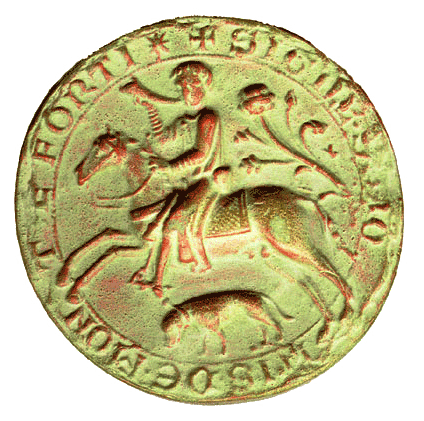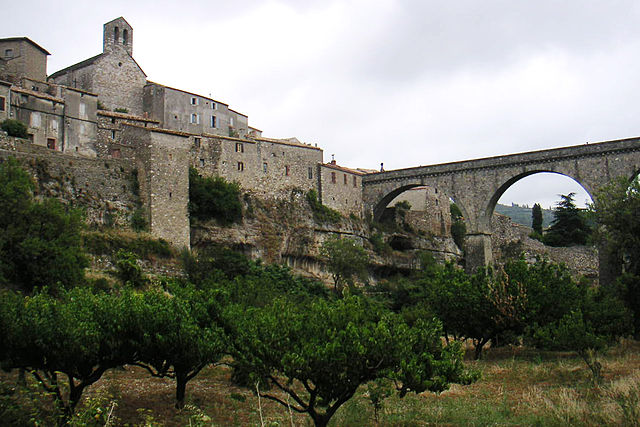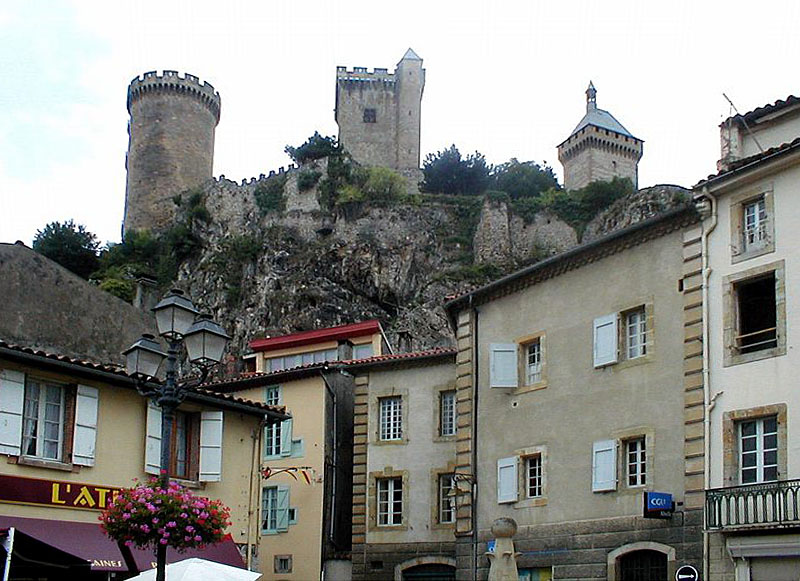 |
| Seal of Simon de Montfort |
The loss of
Carcassonne sent a shock wave throughout Occitane. The Cathar priests went
underground; the perfecti took off
their black robes, disguising themselves as burghers or artisans. The local
seigneurs professed the Catholic faith or took off into the mountains.
The
besiegers at Béziers had failed to distinguish between Catholic and Cathar in
their rapacity and now de Montfort decided to treat the whole region as
heretical. Between them de Montfort and the circa thirty knights of his
personal escort[i]
left with him could call upon the services of around 300 men, and the few
mercenaries that de Montfort could afford.
The region
was up in arms; in the south Raymond-Roger, Count of Foix[ii], had his forces intact
and in the west the Count of Toulouse was a most unreliable ally. And the
region around Limoux and Albi held numerous small strongholds held by the enemy.
Having been elected Viscount of
Béziers de Montfort was finding it difficult to give homage to his new liege
lord, the King of Aragon.
The
inhabitants of the region had reason to be wary of the religious zeal of the Captain-General of the army of the Church. In
1210, after the capture of Bram, which resisted for a mere three days, the
garrison of over 100 men was seized and de Montfort had their eyes gouged out
and noses and upper lips cut off. One man was left with a single eye and de
Montfort deputed him to lead his comrades to the scene of the next planned
action.
The cruelty
was not limited to just the Crusaders; there were instances of;
‘Knights being flayed alive,
chopped into pieces or otherwise mutilated.’[iii]
On both
sides; the influence of religion legitimised a descent into inhumanity; de
Montfort was content to allow rapine, fire slaughter and razing of lands that
he now considered his own. His actions went a long way to destroying what had
hithertofore been a vibrant economy. Simon de Montfort, during his reign of
terror, presided personally over three mass executions of perfecti.
The death of
Raymond-Roger of Béziers induced a revolt among his former vassals and isolated
garrisons were attacked. Forty chateaux were lost in a few months; including
the Chateau of Priexan, taken by the Count of Foix.
De Montfort
was able to alienate with ease those who had sworn oaths to him as their new
overlord. He treated all the Provençal seigneurs as his inferiors including
those who supported him. He distributed lands among his men; that were not his
to give. De Montfort also attempted to enforce French laws and customs on the
south, which had always been separate and different from the northern kingdom
of the Franks.
Regrouping – the de Montfort’s Rally
Minerve
In March
1210 de Montfort’s wife arrived, bring with her 100 much needed troops. De
Montfort retook the chateaux of Priexan and now marched on Minerve, supported
by the citizens of Narbonne. Minerve surrendered after being starved out and
cut off from their water supply. De Montfort was criticised for his leniency by
the Papal Legates. The legates were aware that a large number of perfecti had taken refuge in the city
and presumably wished to make examples of them.
The
negotiations were halted by the legates’ chicanery and the city surrendered
unconditionally. Everyone was expected to recant and repent or die. The
church’s fervent supporters were horrified that the perfecti might escape justice; they were pleased to be proved
wrong.
‘He had them brought forth
from the château; and a great fire having been got ready, more than a hundred
and forty of these heretical perfecti
were flung thereon at the one time.’[iv]
De Montfort
was now in a much stronger position which was boosted by the success of the
three month siege of the chateau at Termes.
Chateau de Termes
The church
was concerned that large numbers of the heretics were to be found in the lands
of one of the Crusaders, the Count of Toulouse. In September 1209 the Papal Legates
presented an indictment against him to the Pope. They claimed that he had not
made good his indemnifying of plundered abbeys and destruction of
fortifications.
By January
1210 Raymond VI had received an audience with the Pope. He claimed;
‘The Legates, who have
treated him exceedingly ill though he had already fulfilled the majority of his
obligations which our Notary….had imposed upon him.’[v]
The count
was treated leniently to ensure that he remained in the church’s camp. Raymond
VI was only to be attacked under Canon law and Arnald-Amalric was determined to
leave this enemy no loophole, and was prepared to use trickery to gain his own
way. In his turn Raymond VI wanted to come to an agreement with de Montfort and
two met in January 1211.
In an
attempt to clear his name, of the heinous
crimes he was accused of by Arnald-Amalric, Raymond VI attended a council at
Arles and was given a list of offensive conditions, not commensurate with one
of the count’s high estate and supporter hereto of the crusade. He was ordered
to;
·
Cease
protecting Jews and heretics and to surrender them within the year
·
Rid
himself of all mercenaries
·
Wear
brown homespun
·
Raze
all properties belonging to him and his nobles to the ground
·
They
were to live like villeins in the countryside; town life was forbidden to them
·
If
attacked by Crusaders they were to proffer no resistance.
These conditions were a considered insult and meant to be
discarded by Raymond. Arnald-Amalric was determined to force Raymond VI to
break with the Crusade, which is what happened. Raymond was much loath to do
so; it went against his pragmatic nature.
Having
declared war by leaving the Legates without an answer Raymond VI was
excommunicated and 6th February 1211 they decreed his domains forfeit
to the first person to take them.
Meanwhile de
Montfort was taking control of what remained of the lands belonging to the
former Viscount of Béziers. He seemed to think that there was no difference in
the fealty of his own vassals and those compelled by force majeur to swear
loyalty to him. Those Occitan knights who were foreworn of their forced oaths
were treated with a deliberate and terrible cruelty by de Montfort. In May 1211
the town of Lavaur saw the largest of the mass killings when four hundred people
were burned to death.
The Siege of Toulouse
In June 1211
de Montfort moved into the lands of the Count of Toulouse, who even now was
attempted peaceable overtures to the Papal Legates, who were pressurising the
Pope to ignore any representation on Raymond’s part.
‘If the Count were to obtain
the restitution of his Chateaux at Your
hands……everything we have done to procure peace in Languedoc would be
annulled.’[vi]
At the same
time there was another auto-da-fé in Cassès.
Raymond VI
had taken refuge in Toulouse and the Crusaders were prepared to smoke him out.
The population in the city was roughly divided between Cathars and Catholics.
The Catholic bishop of Toulouse, having fled to the Crusaders’ camp, now
demanded that the city’s Catholics refuse to obey the orders of Raymond VI and
expel him from the city. If they failed to follow this course of action the
city would be placed under interdict. Their proposals being rejected the city
was made lawful prey for the crusaders.
Simon de
Montfort was forced to lift the siege, as the Crusaders had come to the end of
the Forty days of service to the Cross. His reputation took a huge knock and
lifted the spirits of the heretics. As an alternative to attacking Toulouse the
Crusaders instead laid waste to the lands of the Count of Foix. In the spring
of 1212 new drafts of Crusaders arrived, giving de Montfort the advantage
again.
Chateau of the Comtes de Foix
Mopping Up
Raymond VI
and Raymond-Roger retired to the Aragonese court, leaving de Montfort in
control of the Languedoc. De Montfort had fallen out with Arnald-Amalric, who
had been promoted to Archbishop of Narbonne and had granted himself the title
of Duke. De Montfort summonsed an assembly in Pamiers which granted the church
many material advantages, but failed to give the clerics any role in
government.
De Montfort
was happy to leave the role of outing heretics to the church, while eager to
appropriate their lands. The Pope meanwhile was asking his legates why the
Count of Toulouse, still the rightful seigneur, had not been allowed to enter a
plea of self-justification. This letter of September 1212 was the result of
pressure from Raymond VI and his liege lord, the King of Aragon. The Pope
declared the crusade over and criticised the Legates and de Montfort for
excessive zeal;
‘Certain foxes were destroying the Vine of our Lord in
this Province. They have been caught…..Today
we have to prepare ourselves against a more formidable danger.’[vii]
Peter of Aragon
The Legates
now faced a rather more formidable enemy; Peter II of Aragon who on 16th
July 1212 had beaten the Spanish Moors at the Battle of las Navas de Tolosa. As a champion of the church against
the infidel, Peter’s star was high in Rome. The people of Languedoc sent
representations to Peter requesting that he protect his sovereign rights in the
region. His son wrote;
‘The people of Carcassonne,
of Béziers, and of Toulouse came to my father and told him that only if he
would conquer them, he could become Lord of the Realm.’[viii]
Peter hoped
to divert the crusaders from southern France to fight against the Moors in
Spain. He viewed the crusade in Languedoc as a crusade against his sovereign
rights. Arnald-Amalric now threatened even this saviour of the church in Spain
with excommunication; the church in Languedoc could only be saved by preventing
the Count of Toulouse from regaining his rights.
The Pope,
acting on information from his vindictive Legates now threatened Peter with
‘Divine Wrath, and to take steps
against you such as would result in you suffering grave and irreparable harm.’[ix]
The church
in the middle ages could and did use their powers spiritual to direct the
temporal affairs of nations.
A strong
supporter of the church Peter was angered by the Pope’s attack and even more so
by the refusal to allow him to divorce his wife. In retaliation Peter gathered
an army of one thousand knights to conquer the Languedoc.
Battle of Muret
Peter’s army
besieged Muret but his death in the battle of Muret on 12th
September 1213 led to his men returning to Aragon. De Montfort’s victory meant
a crushing of Aragon’s power in France[x]. De Montfort now spent the
ensuing eighteen months mopping up isolated pockets of opposition to his rule.
He and the Legates were able to use the suspicion of heresy to make enormous
land grabs.
In January
1215 Raymond VI was dispossessed of his lands by the Council of Montpellier;
his lands were given to Simon de Montfort by the church, at the suggestion of
the Papal Legates. By the May the Dauphin Louis, on a
pilgrimage rather than a crusade which was now officially over, entered
Toulouse with de Montfort by his side. De Montfort had been wary of entering
the nest of vipers on his own.
As a token
of appreciation of his assistance Louis returned to Paris bearing with him the
jawbone of St Vincent. One of the side-effects of the crusade had been to
deflect crusader interest in Outremer, resulting in several years of peace in
the region. Sadly that was to change.
Bibliography
Massacre at
Montségur – Zoe Oldenbourg, Weidenfeld & Nicholson 1989
Saint Louis
– Frederick Perry, AMS Press Inc, 1978
The
Thirteenth Century – Sir Maurice Powicke, University of Oxford Press 1988
The Templars
– Piers Paul Reid, Weidenfeld & Nicholson 2000
The Monks of
War – Desmond Seward, the Folio Society 2000
www.wikipedia.en
[i]
Some were neighbours or relatives. Later de Montfort’s brother Guy was to
return from crusading in the Holy Land to join him
[ii]
Not to be confused with Raymond-Roger, Viscount of Béziers, now deceased
[iii]
Montségur - Oldenbourg
[iv]
Ibid
[v]
Ibid
[vi]
Ibid
[vii]
Ibid
[viii]
Ibid
[ix]
Ibid
[x]
Peter’s son James was a four year old child

_vus_depuis_l'Est.jpg/450px-Le_ch%C3%A2teau_et_le_village_de_Termes_(Aude)_vus_depuis_l'Est.jpg)



No comments:
Post a Comment
Note: only a member of this blog may post a comment.